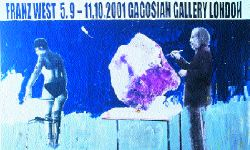Franz West
Gagosian Gallery, London, UK
Gagosian Gallery, London, UK

Writing differs from making art in that it's a largely sedentary pursuit, and as such, any opportunity to sit down when visiting a gallery speaks directly to the sloth inside me. Not that there's anything sloth-like about writers, but I just don't see that there's much wrong with shifting the weight off your feet in order to contemplate art. Neither does Franz West, although the premium set by the artist extends beyond simple repose.
For his recent show at Gagosian, West presented new configurations of his ongoing series of 'Adaptives' which range from odd, amorphous plaster lumps to pieces of furniture, collages and a small grouping of collaborative pieces. West's work reminds me of those timeless logical puzzles beloved of campfire stoners and solipsistic undergraduate philosophers alike: 'If there is a scream in a forest, but there is no one around to hear it, then did the scream actually occur?' or perhaps the old Buddhist exhortation to imagine the sound of one hand clapping. It's all about that point where one body completes another, or two separate objects are needed in order to create a phenomenological event. Whether sat on one of his Bauhaus-style arse-cripplers or a rather elegant Jungendstil couch, sitting is intended to become an act of completion - these objects demand to be used, employing a kind of creativity which is reliant on audience participation. Rather like Erwin Wurm's 'One Minute Sculptures', West's prosthetics (in this show an awkward plaster mitten wielded in a pathetically slapstick fashion by 'actors' on an accompanying monitor) are designed to push the human body into poses and postures that aim to set up an absurd interdependent relationship between participation and observation.
The idea of West's project, however, seems at odds with the end result - it doesn't quite do what it says on the tin. I suspect that no matter how long you sportingly became a West addendum, the work would never let you experience the satisfied afterglow of having worked out on the same kind of intellectual jungle gym that proper philosophical speculation gives. Within the imposing commercial walls of the Gagosian, West's work emitted an aura of self-satisfaction, as if the participation of a viewer in its 'completion' would spoil the careful sculptural composition. The human element hardly seemed an important part of the equation - rather like one hand being a bit diffident to the other's wish to clap.
Hailing from a very particular Viennese artistic milieu, West's work can be read as a kind of anti-Aktionism - quiet performance freed from the Sturm und Drang of your Mühls and Nitschs by a humour that sees no need for histrionics, but instead looks to the economies of human scale and everyday acts for its insights. The trouble is that its demonstrative desire trips over its ironic formalism, turning the project into the kind of internal memorandum that contemporary art practice sends to itself. It reduces clarity to the indistinct level of knowing references and frankly lame humour. The utopian social implications of West's work - making clear the importance of the moment where humans 'activate' design or art by sitting, looking or hanging out - are heavy with potential, if only they could be shaken from the rut of self-regard that this kind of art is intent on digging for itself. Maybe now's not the time to sit down.

























